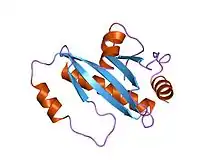| YopH_N terminal protein domain | |||||||||
|---|---|---|---|---|---|---|---|---|---|
 Crystal structure of the Yersinia pestis type III secretion chaperone sych in complex with a stable fragment of YSCM2 | |||||||||
| Identifiers | |||||||||
| Symbol | YopH_N | ||||||||
| Pfam | PF09013 | ||||||||
| InterPro | IPR015103 | ||||||||
| |||||||||
In molecular biology, YopH, N-terminal refers to an evolutionary conserved protein domain. This entry represents the N-terminal domain of YopH protein tyrosine phosphatase (PTP).
Function
Protein tyrosine (pTyr) phosphorylation is a common post-translational modification which can create novel recognition motifs for protein interactions and cellular localisation, affect protein stability, and regulate enzyme activity. Consequently, maintaining an appropriate level of protein tyrosine phosphorylation is essential for many cellular functions. Tyrosine-specific protein phosphatases (PTPase; EC) catalyse the removal of a phosphate group attached to a tyrosine residue, using a cysteinyl-phosphate enzyme intermediate. These enzymes are key regulatory components in signal transduction pathways (such as the MAP kinase pathway) and cell cycle control, and are important in the control of cell growth, proliferation, differentiation and transformation.[1][2]
Classification
The PTP superfamily can be divided into four subfamilies:[3]
- pTyr-specific phosphatases
- dual specificity phosphatases (dTyr and dSer/dThr)
- Cdc25 phosphatases (dTyr and/or dThr)
- LMW (low molecular weight) phosphatases
Based on their cellular localisation, PTPases are also classified as:
- Receptor-like, which are transmembrane receptors that contain PTPase domains[4]
- Non-receptor (intracellular) PTPases [5]
Structure
This domain has a compact structure composed of four alpha-helices and two beta-hairpins. Helices alpha-1 and alpha-3 are parallel to each other and antiparallel to helices alpha-2 and alpha-4. This domain targets YopH for secretion from the bacterium and translocation into eukaryotic cells, and has phosphotyrosyl peptide-binding activity, allowing for recognition of p130Cas and paxillin.[6] YopH from Yersinia sp. is essential for pathogenesis, as it allows the bacteria to resist phagocytosis by host macrophages through its ability to dephosphorylate host proteins, thereby interfering with the host signalling process. Yersinia has one of the most active PTP enzymes known. YopH contains a loop of ten amino acids (the WPD loop) that covers the entrance of the active site of the enzyme during substrate binding.[7]
All PTPases carry the highly conserved active site motif C(X)5R (PTP signature motif), employ a common catalytic mechanism, and share a similar core structure made of a central parallel beta-sheet with flanking alpha-helices containing a beta-loop-alpha-loop that encompasses the PTP signature motif.[8] Functional diversity between PTPases is endowed by regulatory domains and subunits.
Homology
A homologous domain is found in YscM (Yop secretion protein M), which acts as a Yop protein translocation protein. Several Yop proteins are involved in pathogenesis. YscM is produced by the virulence operon virC, which encodes thirteen genes, yscA-M.[9] Transcription of the virC operon was subjected to the same regulation as the yop genes.
References
- ↑ Denu JM, Dixon JE (October 1998). "Protein tyrosine phosphatases: mechanisms of catalysis and regulation". Curr Opin Chem Biol. 2 (5): 633–41. doi:10.1016/S1367-5931(98)80095-1. PMID 9818190.
- ↑ Paul S, Lombroso PJ (November 2003). "Receptor and nonreceptor protein tyrosine phosphatases in the nervous system". Cell. Mol. Life Sci. 60 (11): 2465–82. doi:10.1007/s00018-003-3123-7. PMID 14625689. S2CID 10827975.
- ↑ Wang WQ, Sun JP, Zhang ZY (2003). "An overview of the protein tyrosine phosphatase superfamily". Curr Top Med Chem. 3 (7): 739–48. doi:10.2174/1568026033452302. PMID 12678841.
- ↑ Eswaran J, Debreczeni JE, Longman E, Barr AJ, Knapp S (June 2006). "The crystal structure of human receptor protein tyrosine phosphatase kappa phosphatase domain 1". Protein Sci. 15 (6): 1500–5. doi:10.1110/ps.062128706. PMC 2242534. PMID 16672235.
- ↑ Perkins LA, Johnson MR, Melnick MB, Perrimon N (November 1996). "The nonreceptor protein tyrosine phosphatase corkscrew functions in multiple receptor tyrosine kinase pathways in Drosophila". Dev. Biol. 180 (1): 63–81. doi:10.1006/dbio.1996.0285. PMID 8948575.
{{cite journal}}: CS1 maint: multiple names: authors list (link) - ↑ Evdokimov AG, Tropea JE, Routzahn KM, Copeland TD, Waugh DS (June 2001). "Structure of the N-terminal domain of Yersinia pestis YopH at 2.0 A resolution". Acta Crystallogr. D. 57 (Pt 6): 793–9. doi:10.1107/s0907444901004875. PMID 11375498.
- ↑ Khajehpour M, Wu L, Liu S, Zhadin N, Zhang ZY, Callender R (April 2007). "Loop dynamics and ligand binding kinetics in the reaction catalyzed by the Yersinia protein tyrosine phosphatase". Biochemistry. 46 (14): 4370–8. doi:10.1021/bi602335x. PMID 17352459.
- ↑ Barford D, Das AK, Egloff MP (1998). "The structure and mechanism of protein phosphatases: insights into catalysis and regulation". Annu Rev Biophys Biomol Struct. 27: 133–64. doi:10.1146/annurev.biophys.27.1.133. PMID 9646865.
- ↑ Michiels T, Vanooteghem JC, Lambert de Rouvroit C, China B, Gustin A, Boudry P, Cornelis GR (August 1991). "Analysis of virC, an operon involved in the secretion of Yop proteins by Yersinia enterocolitica". J. Bacteriol. 173 (16): 4994–5009. doi:10.1128/jb.173.16.4994-5009.1991. PMC 208188. PMID 1860816.